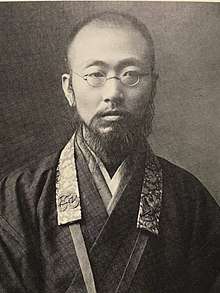Akegarasu Haya
Akegarasu Haya (暁烏 敏, 1877-1954) was a Shin Buddhist student of Kiyozawa Manshi for a decade. Akegarasu was a former head of administration of the Higashi Hongan-ji who was a major inspiration to the formation of the Dobokai Movement.[1]

| Part of a series on |
| Buddhism |
|---|
 |
|
|
|
Early life
He was born into a Jodo Shinshu temple family in Ishikawa prefecture and was the family's only son. Due to his father Enen's death when he was 10, his mother Taki struggled through the hardships associated with poverty and single parenthood while raising him. He received traditionalist Jōdo Shinshū teachings until his fateful meeting, and by the age of fourteen, the talented writer had published several books of 31-syllable poetry.
Revival movement
Rev. Kiyozawa Manshi, a great Japanese Shin reformer who taught Buddhism through life experience, met him on September 11, 1893, and became his teacher. Akegarasu was 16 and Kiyozawa was 31. For approximately the next ten years the two attempted to translate Buddhism into ordinary language and to manifest it into their simple everyday living. When Kiyozawa died on June 6, 1903, Akegarasu felt that he had been thoroughly crushed by his teacher's teachings. Akegarasu then led Kiyozawa's revival movement and wrote extensively for the next decade.[2]
A series of severe crises struck Rev. Akegarasu during his mid-30s. His wife died, then his reputation as a minister and as the leader of Rev. Kiyozawa's revival movement came under attack by party-spirit factionalists. At that time, the Amitābha Buddha image that Rev. Akegarasu cherished was shattered, and no traditional forms of practice satisfied. But upon re-reading the Longer Sukhāvatīvyūha Sūtra he felt that he was finally beginning to realize the essential message of his teacher Rev. Kiyozawa, via the text of that Sutra. His experiential insight was that the story of Larger Sutra, where the hero, Dharmakara Bodhisattva, eventually becomes Amida Buddha, was expressing a timeless spirit emerging then and there within his own heart-mind. Amida's primal vow was his own authentic aspiration to become a Buddha and to save all sentient beings. From then on he taught that Amida Buddha represents that which practitioners should become.[3]
In 1949, Akegarasu focused Shin practice in the direction of faith alone, declaring in a statement to his disciples: "First shinjin, second shinjin, third shinjin." This is basically the moment where Dobokai became official, although the movement did not receive official recognition until 1962. The early roots for the Dobokai Movement faith movement began in 1947 as the shinjinsha, or, 'true person community'.[1]
Death
Akegarasu died August 27, 1954.[4]
Writings
The earliest English translation of Akegarasu's writings can be found in Selections From The Nippon Seishin Library, which Akegarasu published in 1936 (translators Hata Taigan, Hanaoka Kimi, Imadate Tosui and others).[5] In 1977 to commemorate the centennial of Akegarasu's birth, two ministers of the Buddhist Temple of Chicago who were his direct students published their translations: The Fundamental Spirit of Buddhism translated by Gyomay Kubose with Nancy DeRoin[6] and Shout of Buddha: Writings of Haya Akegarasu translated by Gyoko Saito with Joan Sweany.[7]
One of Akegarasu's main students was Shuichi Maida (1906-1967). Gyoko Saito and Gyomay Kubose were also among his prominent students.[8] [9] [10]
Akegarasu's poem “Who am I?” concludes:
I alone
am the most noble:
I embrace the cosmos.
What an indescribable, subtle
existence I am! - I cannot in
speaking or writing
put down who I am!
I always touch this indescribable self,
always follow this indescribable self.
Truth is here.[11]
References
- Popular Buddhism In Japan: Shin Buddhist Religion & Culture by Esben Andreasen, pp. 46,71,72 / University of Hawaii Press 1998, ISBN 0-8248-2028-2
- Shout of the Buddha: Writings of Hays Akegarasu translated by Gyoto Saito and Joan Sweany (1977) Orchid Press, pp.vii-ix
- “The Life and Thought of Rev. Haya Akegarasu” by Rev. Marvin Harada (April 12, 2015) Orange County Buddhist Church
- Heard By Me: Essays on My Buddhist Teacher by Shuichi Maida, translated by Nobuo Haneda, p. 194 / Berkeley: Frog Press 1992, ISBN 0-9627231-0-X
- Selections From The Nippon Seishin Library / Kita-yasuda, Ishikawa: Koso 1936, OCLC 4383762
- The Fundamental Spirit of Buddhism by Haya Akegarasu, translated by Gyomay M. Kubose (with Nancy DeRoin) / Chicago: Buddhist Educational Center 1977, OCLC 84284631
- Shout of Buddha: Writings of Haya Akegarasu translated by Gyoko Saito and Joan Sweany / Chicago: Orchid Press 1977, OCLC 8224165
- Shuichi Maida (Author), Nobuo Haneda (Translator). The Evil Person: Essays on Shin Buddhism; CreateSpace Independent Publishing Platform; Second edition (June 10, 2016)
- Bright Dawn Center of Oneness Buddhism
- Shout of the Buddha: Writings of Haya Akegarasu translated by Gyoto Saito and Joan Sweany (1977) Orchid Press, p.197